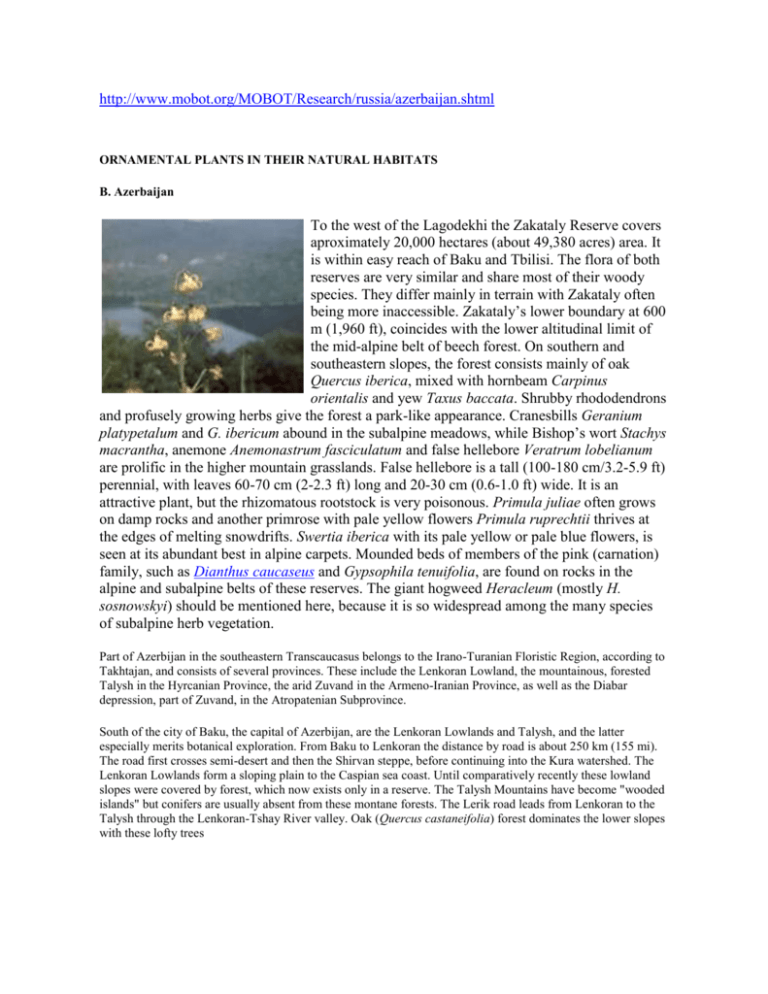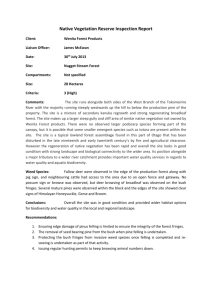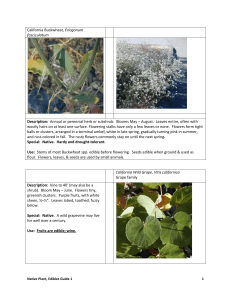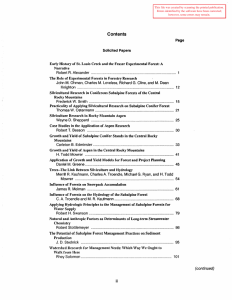Ornament Plants in their Natural Habitats: Azerbaijan.
advertisement

http://www.mobot.org/MOBOT/Research/russia/azerbaijan.shtml ORNAMENTAL PLANTS IN THEIR NATURAL HABITATS B. Azerbaijan To the west of the Lagodekhi the Zakataly Reserve covers aproximately 20,000 hectares (about 49,380 acres) area. It is within easy reach of Baku and Tbilisi. The flora of both reserves are very similar and share most of their woody species. They differ mainly in terrain with Zakataly often being more inaccessible. Zakataly’s lower boundary at 600 m (1,960 ft), coincides with the lower altitudinal limit of the mid-alpine belt of beech forest. On southern and southeastern slopes, the forest consists mainly of oak Quercus iberica, mixed with hornbeam Carpinus orientalis and yew Taxus baccata. Shrubby rhododendrons and profusely growing herbs give the forest a park-like appearance. Cranesbills Geranium platypetalum and G. ibericum abound in the subalpine meadows, while Bishop’s wort Stachys macrantha, anemone Anemonastrum fasciculatum and false hellebore Veratrum lobelianum are prolific in the higher mountain grasslands. False hellebore is a tall (100-180 cm/3.2-5.9 ft) perennial, with leaves 60-70 cm (2-2.3 ft) long and 20-30 cm (0.6-1.0 ft) wide. It is an attractive plant, but the rhizomatous rootstock is very poisonous. Primula juliae often grows on damp rocks and another primrose with pale yellow flowers Primula ruprechtii thrives at the edges of melting snowdrifts. Swertia iberica with its pale yellow or pale blue flowers, is seen at its abundant best in alpine carpets. Mounded beds of members of the pink (carnation) family, such as Dianthus caucaseus and Gypsophila tenuifolia, are found on rocks in the alpine and subalpine belts of these reserves. The giant hogweed Heracleum (mostly H. sosnowskyi) should be mentioned here, because it is so widespread among the many species of subalpine herb vegetation. Part of Azerbijan in the southeastern Transcaucasus belongs to the Irano-Turanian Floristic Region, according to Takhtajan, and consists of several provinces. These include the Lenkoran Lowland, the mountainous, forested Talysh in the Hyrcanian Province, the arid Zuvand in the Armeno-Iranian Province, as well as the Diabar depression, part of Zuvand, in the Atropatenian Subprovince. South of the city of Baku, the capital of Azerbijan, are the Lenkoran Lowlands and Talysh, and the latter especially merits botanical exploration. From Baku to Lenkoran the distance by road is about 250 km (155 mi). The road first crosses semi-desert and then the Shirvan steppe, before continuing into the Kura watershed. The Lenkoran Lowlands form a sloping plain to the Caspian sea coast. Until comparatively recently these lowland slopes were covered by forest, which now exists only in a reserve. The Talysh Mountains have become "wooded islands" but conifers are usually absent from these montane forests. The Lerik road leads from Lenkoran to the Talysh through the Lenkoran-Tshay River valley. Oak (Quercus castaneifolia) forest dominates the lower slopes with these lofty trees bearing large, greyish-green leaves. Other woodland species include hornbeam Carpinus orientalis, silk tree Albizia julibrissin, fig Ficus carica, honey locust Gleditsia caspia and pomegranate Punica granatum. Persian ironwood Parrotia persica, a member of a monotypic genus, endemic to Talysh and the northern Iran, also grows here, and when it forms a nearly pure stand, the overall impression is of an enchanted forest, trunks and branches fusing and growing together, lichens hanging from the branches, and the forest floor covered with dead leaves. Heavy shade dominates the floor of these tall forests and undergrowth is almost absent. In autumn, a spectacular display is created by the color change of its foliage, as the ironwood's yellow leaves become faintly tinged with lilac. The Talysh forests have been called "Hyrcanian" by botanists as an indication of their age (Grossheim, 1960). The Hyrcanian Sea filled an ancient large basin and was the predecessor of today’s smaller Caspian Sea. However, the Talysh mountains were never submerged, and this is why the endemic Parrotia persica and relictual Quercus castaneifolia and Danae racemosa (Alexandrian laurel) have persisted here since the early Tertiary period. The Talysh herbaceous endemics are of considerable horticultural interest because of their highly attractive nature. The most impressive perennials are the large-flowered Iridodictyum hyrcanum [=Iris hyrcana], a fragrant and showy white-flowered lily Lilium ledebourii and a large, dark, vine-brown-flowered fritillary Fritillaria grandiflora. The last was collected and described by A. A. Grossheim, the prominent Russian, who called this fritillary the gem of Talysh flora (Grossheim, 1960). The species is extremely rare in nature and in cultivation. The same is true of the blue-flowered Crocus polyanthus. More extensively distributed in Talysh are bulbous plants of the genera Muscari, Gagea, Tulipa and Pushkinia; the last with pale-blue flowers was named after Mussin-Pushkin, a noted Russian chemist and mineralogist, who collected this plant in 1802. The yellow-pink-flowered paeony Paeonia tomentosa, followed by a scarlet poppy Papaver bracteatum are common in Talysh; their large and attractive flowers bloom in late April and early May. Phuopsis stylosa, a herbaceous perennial with whorled leaves, produces terminal heads of bright pink flowers. In Talysh, this plant grows from the coastal lowlands up to the altitudinal limits of mountain forest and is spectacular when flowering in profusion. Because of its low rainfall, Zuvand's vegetation differs markedly from that of rest of Talysh. Many of its plants have special peculiarities to withstand long periods of drought. Most species of milk vetch (Astragalus) and prickly thrift (Acantholimon) form compact spiky cushions, while other grow only during the short, moist spring, e.g. bulbous plants. Here, in Zuvand, species of iris and wild gladioli are of interest. The gladioli flowers vary very much in colour, and can be bright pink, or lilac in the mountains, or deep lilac in arid habitats (Gladiolus atroviolaceus). ORNAMENTAL PLANTS FROM RUSSIA











